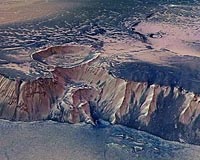 |
for Astrobiology Magazine Moffet Field CA (SPX) Nov 17, 2009 Scientists with NASA's IceBite project are heading this week for University Valley, a hanging valley perched more than 1600 feet (more than 1 mile) above sea level in Antarctica's McMurdo Dry Valleys. Their objective: to test a set of ice-penetrating drills and select one for use on a future mission to the martian polar north, the same region of the planet that NASA's Phoenix lander investigated in 2008. The northern polar region on Mars is of particular interest to scientists because it once may have provided a habitable environment for life. Due to variations over time in Mars' orbit and the angle at which it tilts toward the sun, Mars' north pole received much more sunlight several million years ago than it does today - enough sunlight to produce liquid water, enough liquid water to support life. Indeed NASA's Phoenix lander found evidence in martian Arctic soil that liquid water had been present there in the past. That makes the martian northern plains a favored place for a future mission to Mars targeted at the search for life. And it makes analogue sites on Earth, locations that mimic the conditions encountered by Phoenix, a good place to prepare for a Phoenix follow-up mission. University Valley, where IceBite researchers will conduct their field work, is just such a site. Although permafrost exists in many places on Earth, it is typically wet permafrost. "Everywhere in the northern hemisphere where there's permafrost, it is wet and it gets muddy in the summer," explains Chris McKay of NASA Ames, IceBite's principal investigator. "There is always a point in the summer where you have wet soil and then ice and so the temperature at that boundary is zero degrees [Celsius]." But in 2008, when NASA's Phoenix lander studied a small patch of ground in Mars' northern polar region, it found a layer of bone-dry, frozen soil - dry permafrost - sitting atop a layer of ice. On Earth, however, there is only one place where dry soil overlays solid ice: in the upper elevations of the Dry Valleys. "In Antarctica, and only in Antarctica, we find a completely different phenomenon called dry permafrost," says McKay. "The whole system never gets warm enough for that ice to turn to liquid. That's the relevant model for Mars." An unnamed glacier fills the upper end of University Valley. At the tip of the glacier, ice is present at the surface and there is no overlying soil. Here, during the summer months the surface warms enough for melting to occur. But the farther one moves away from the glacier, the deeper the overlying soil layer becomes, eventually becoming so deep that the ice beneath it never warms above minus 10 degrees Celsius (14 degrees Fahrenheit), so liquid water never appears, and the permafrost above the ice remains dry year-round. This is where McKay's team plans to drill. The IceBite project, funded by NASA's ASTEP (Astrobiology Science and Technology for Exploring Planets) program, will spend three austral summers in Antarctica. This year, the team's focus will be on scouting the area to identify the best locations for drilling. "We'll look at the physics of the soil, the water moisture. We'll look at the snow packs that are surrounding the valley. And we'll stick in all sorts of data loggers and temperature and environmental loggers to record what's going on," says McKay. IceBite scientists are also interested in studying the microorganisms that live under these challenging conditions. So in addition to scouting the area for drill sites, McKay and his colleagues plan to collect samples, for laboratory study, of organisms that live in the ice, in the dry permafrost, and on the boundary where they meet. Bacteria have been found living in ice at temperatures even colder than minus 10 Celsius. "We know that's a habitat for growth," McKay says. And in past visits to Antarctica, organisms have also been found in the dry permafrost. "Ice and dirt mixed together at minus 10 [Celsius] is plenty of water for life," McKay says. But whether the organisms are growing and reproducing in the dry soil, or are merely lying dormant, is still unknown. "One of the things we want to do is stick sensors in there and see if the water activity gets high enough for them to have seasonal growth." Astrobiology Magazine will be in contact with the science team throughout the six-week period when they are in the field in Antarctica, and we invite all our readers to use our "Ask a Question" feature (the red buttons at the top and buttom of the page) to pose direct questions to team members about the IceBite project. Share This Article With Planet Earth
Related Links ASTEP (Astrobiology Science and Technology for Exploring Planets) program Mars News and Information at MarsDaily.com Lunar Dreams and more
 A Tale Of Planetary Woe
A Tale Of Planetary WoeHuntsville AL (SPX) Nov 09, 2009 Once upon a time - roughly four billion years ago - Mars was warm and wet, much like Earth. Liquid water flowed on the Martian surface in long rivers that emptied into shallow seas. A thick atmosphere blanketed the planet and kept it warm. Living microbes might have even arisen, some scientists believe, starting Mars down the path toward becoming a second life-filled planet next door to our own. ... read more |
|
| The content herein, unless otherwise known to be public domain, are Copyright 1995-2009 - SpaceDaily. AFP and UPI Wire Stories are copyright Agence France-Presse and United Press International. ESA Portal Reports are copyright European Space Agency. All NASA sourced material is public domain. Additional copyrights may apply in whole or part to other bona fide parties. Advertising does not imply endorsement,agreement or approval of any opinions, statements or information provided by SpaceDaily on any Web page published or hosted by SpaceDaily. Privacy Statement |